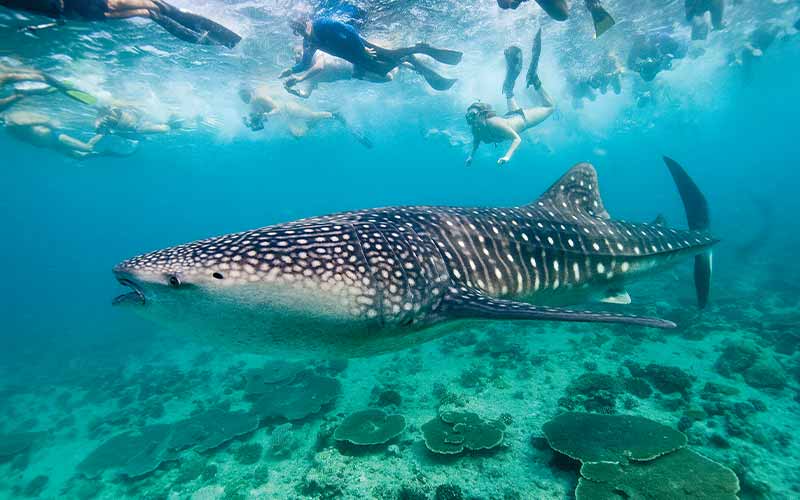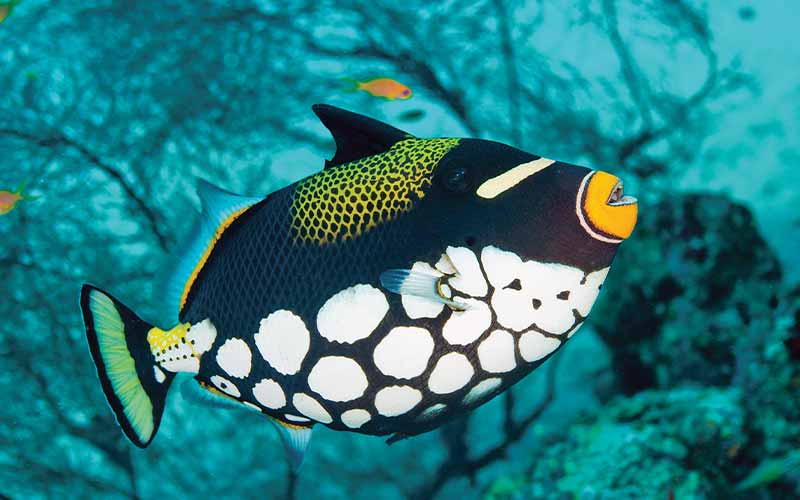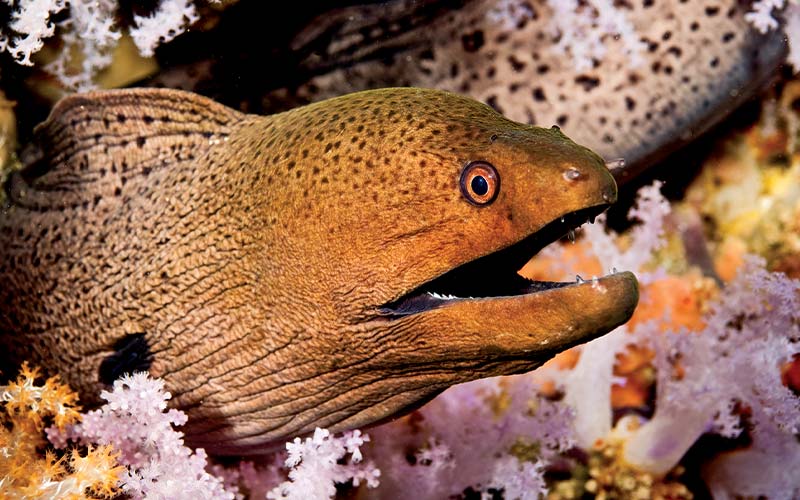We had just survived the long flight from Miami to Houston to Dubai to Male; admittedly, we were a bit foggy. Yet when David Mesnard of the Ocean Dancer liveaboard began the trip briefing with the list of things we were likely to see, he mentioned both whale sharks and manta rays. I’d done enough advance research on the Maldives to accept we’d almost inevitably see mantas somewhere along the way, but his confident prediction that we’d also see whale sharks shook me out of my jet lag-induced coma long enough to challenge him on the matter.
“OK, David,” I said. “What is the real probability we’ll actually see a whale shark?”
He shrugged and said, “Oh, about 98 percent.”
If I’d done my homework better, I would have realized that whale sharks are indeed common in Maldivian waters, which made me likewise ponder what other elements of the Maldives dive experience are predictable enough to be considered certainties for visiting divers.
Waiting on Whale Sharks

It didn’t take long to see why Mesnard could make such a confident prediction. The whale shark encounters we enjoyed took place at the south end of Ari Atoll, home to a resort development called “Holiday Island” and a steady stream of whale sharks who come to feed on plankton. On the first dive of the day, Mesnard and two of our guests had an extraordinary nine-minute dive with the most mellow, beautiful whale shark I have ever seen. I know this because I saw the video, not because I was actually there.
Whale shark spotting takes patience, and by the time mine wore thin enough to be distracted by a turtle under a coral ledge, those who persevered with their disciplined view to the blue were rewarded with a most magical encounter. I should have been happy for them, but, competitive human nature being what it is, I wanted my very own whale shark encounter!
My wish came true on the next dive, but it lacked the solitude and majesty of the earlier experience my fellow divers had enjoyed. By the second dive, it seemed that most of the people vacationing in the 142 bungalows at Holiday Island were now out on various boats searching for whale sharks. When any were sighted near the surface, it was sheer pandemonium. The whale sharks swam on, seemingly oblivious, but there was a dense gaggle of bodies in motion, snorkeling all about these placid creatures. The more athletic among them descended to get photographs, but most swam along as they were able, and eventually their boat would pick them up and drop them at the head of the pack again. There were no discernible rules, but I didn’t see anyone riding or otherwise interfering with the whale sharks either.

Of course, our group of elite photographers felt we should be first to the encounter, yet we were no different from anyone else in terms of fair-and-balanced access to whale sharks. In fact, that same week, possibly that same day, there was a post by “Flaperoo” on TripAdvisor.com. It was, in her words: “the greatest experience of this amazing holiday. Swimming with not one, but six whale sharks. There is no guarantee any will turn up, and we had been out on previous occasions and not seen any. On our second to last day, we went on the whale shark trip again; I just could not believe what I saw. I knew at the time I was experiencing something truly amazing and still do. It will stay with me for the rest of my life.
“They were completely tolerant of a shoal of very excited, flipper-splashing tourists jumping into the water beside them; I felt totally honored that they allowed me to share some time with them. When we all got back on the boat for the last time, there was silence on the journey back to Holiday Island; everyone seemed overwhelmed by the experience. It was a holiday experience I will never forget and probably the best I have ever had.”

Clearly, swimming with any whale shark at any time is a very special encounter. That it may have to be shared with others is a likely consequence of this locale.
That afternoon on a reef known as Maamigili Beyru (Beyru means “outside”), we had several far more intimate encounters with whale sharks, both while diving and snorkeling. Everyone on our boat had extraordinary whale shark encounters this day, and Mesnard’s 98 percent probability had been elevated to a certainty.
Random Manta Rays
Maldivian waters are thick with manta rays. In fact, Hanifaru Bay in the Baa Atoll is one of the great manta concentrations to be found anywhere. From May through November, currents and upwellings carry a superabundance of plankton into the bay, and divers will often find as many as 20 to 50 manta rays on a single dive. Researcher Guy Stevens, senior marine biologist for the Four Seasons Resort Maldives, routinely reports seeing 200 manta rays per dive in Hanifaru Lagoon during this time. Add to that mass-o-manta the whale sharks that are also attracted to the planktivorous feast, and you have a filter-feeding frenzy unlike any in the world.

Our experience was not quite so extreme, but we did see a lot of mantas over the course of our expedition. The most notable encounter was at Dhon Kalo Thila, where divers gently ride the incoming current to a sandy substrate in the middle of the channel at a depth of 65 to 70 feet. There is a cleaning station for the mantas there, and if divers just settle in, tucked out of the flow, the mantas will come very, very close.
Swimming after them tends to be counterproductive, but for those with the combination of patience and enough bottom time for the mantas to become comfortable with their presence, this is a reliably spectacular dive. However, as magnificent as this encounter is, my best manta shots came from random encounters along the reef, mostly in very shallow water. I’d see manta rays swimming toward me, and if I just remained positioned in an intersecting path, they would swim very near. Maybe I’d get only one pass, sometimes a few, but the encounters were frequent enough to conclude there are lots of mantas in the Maldives.

Unrivaled Reef Scenics
Of the 425 coral atolls found in the world’s tropical seas, 26 are in the Maldives, and they provide incredible opportunities for photographers in search of scenic reef shots. In fact, the term atoll is derived from the Maldivian word “atholhu,” meaning “interior,” likely referring to the enclosed lagoon. Originally, perhaps 65 million years ago, the Maldives were high volcanic islands, providing a base for coral colonization.
Rising sea levels over time created a significant fringing reef, and erosive factors of rain and currents created passes into the interior lagoon of what became essentially a submerged mountain. Diving those passes on an incoming tide for the combination of clear water and the security of not being swept out to sea reveals a world of rich soft corals, healthy shallow reefs and fish — lots and lots of fish.

Maldives diving is structured according to the geological formation of the reef: channels, farus, thilas or giris. A channel, or kandu, is a deep chasm in the rim of an atoll connecting a lagoon with the open ocean. There can be significant current in a kandu, and they are dived on an incoming tide, sweeping divers into the safety of the lagoon for easy pick up by the dhoni.
A faru is a circular reef rising from the ocean floor, typically within a channel. Farus boast beautiful ledges and overhangs, and a current-swept point that is generally good for pelagic action. It also creates a relatively quiet lee when you need to escape the current.
A thila is an underwater reef formed inside the atoll, usually beginning in 18 to 30 feet of water. Some are small enough to allow a diver to circumnavigate on a single dive, but the better soft coral and marine life action will be found at the point of the current.

Finally, a giri is a small area of coral, smaller than a thila; it is also found inside the atoll. Typically there is no current along a giri, and they are shallow, effortless dives.
I found the Maldives to be one of the world’s great destinations for photographing small and medium-sized reef fish. There are better muck destinations, for sure, and places like Raja Ampat are recognized to have greater biodiversity. But, unlike Raja Ampat, where I find the fish oddly skittish, in the Maldives the reef dwellers are quite approachable. I presume they are accustomed to seeing divers, especially given the popularity of this destination for European travelers.
Additionally, many of the sites are washed by current, which keeps the fish tucked into overhangs and lees where food is brought to them and minimal energy expended. The other significant advantage to fish photography in the Maldives is that the backgrounds are extraordinarily beautiful, enhancing the wider “environmental portrait” shot as compared to a simple “fish ID” shot. For a marine life photographer, or simply a fish-watcher, there are few Indo-Pacific destinations of greater opportunity than the Maldives.
Sun, Sand and Cell Service

Topside beauty is one of the primary attractions of the Maldives; in their zeal to log bottom time, divers may underappreciate this. We had a little additional motivation to visit the islands on our trip when a local fisherman accidentally caught a small turtle in his net; the fisherman, knowing Mesnard’s strong ecological spirit, had entrusted him with its care. Koki, as the turtle is now named, lived for a while in a small tub aboard the Ocean Dancer.
Mesnard’s intent was to protect the turtle until his protective shell had fully developed, and he took Koki on daily swims. Whenever they did their shore excursions for exercise, I usually tagged along to visit islands of white-sand beaches, palm trees and crystalline water nourishing shallow coral reefs.

Throughout our entire Maldives adventure, we were connected to the world back home; there were cell phone towers on virtually every island we passed. As we cruised through this idyllic tropical paradise, we found it incongruous that our guests were receiving text messages describing 3-foot snowfalls and power outages back in their real worlds.
Yet, for a short time, while cruising the Maldives by luxury liveaboard, that reality was largely suspended as we drifted along walls festooned with every imaginable hue of soft coral, swam with whale sharks and watched manta rays cleaned of parasites just feet from our cameras. Suspension of reality is what the Maldives does very well, coupled with the substitution of a new reality, one altogether benign and magically tropical.

© Alert Diver — Q3 Spring 2010